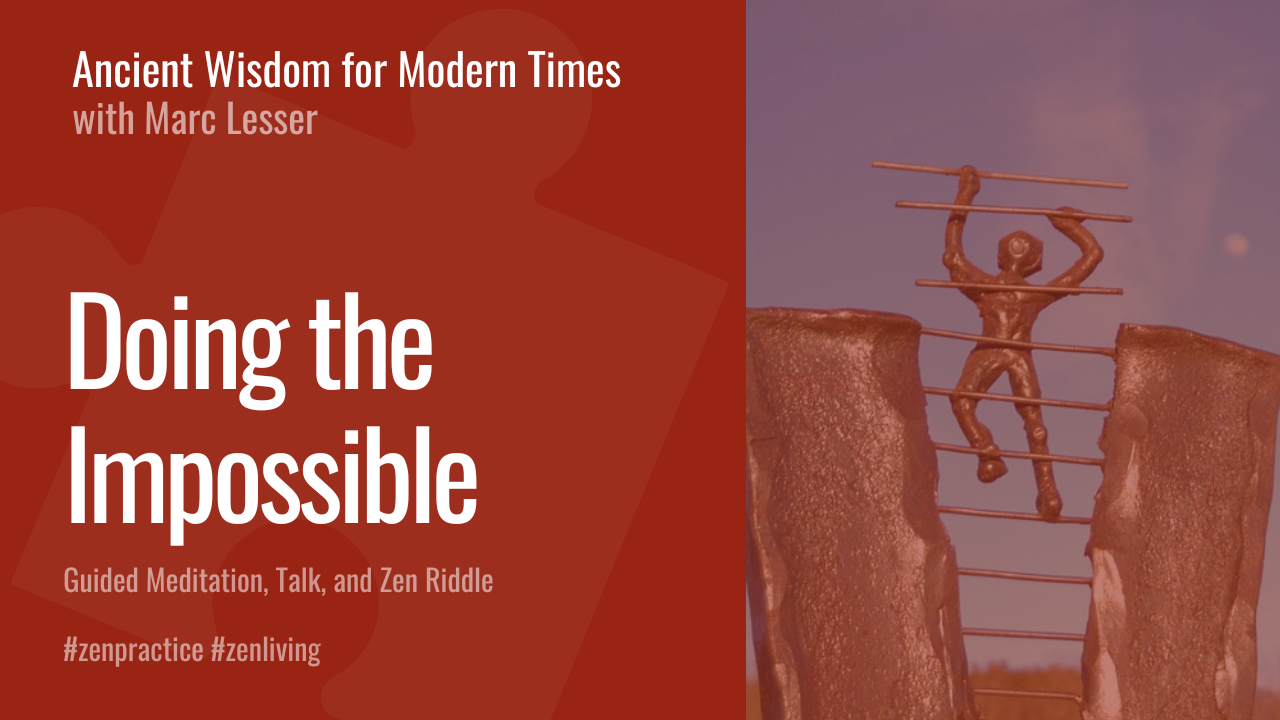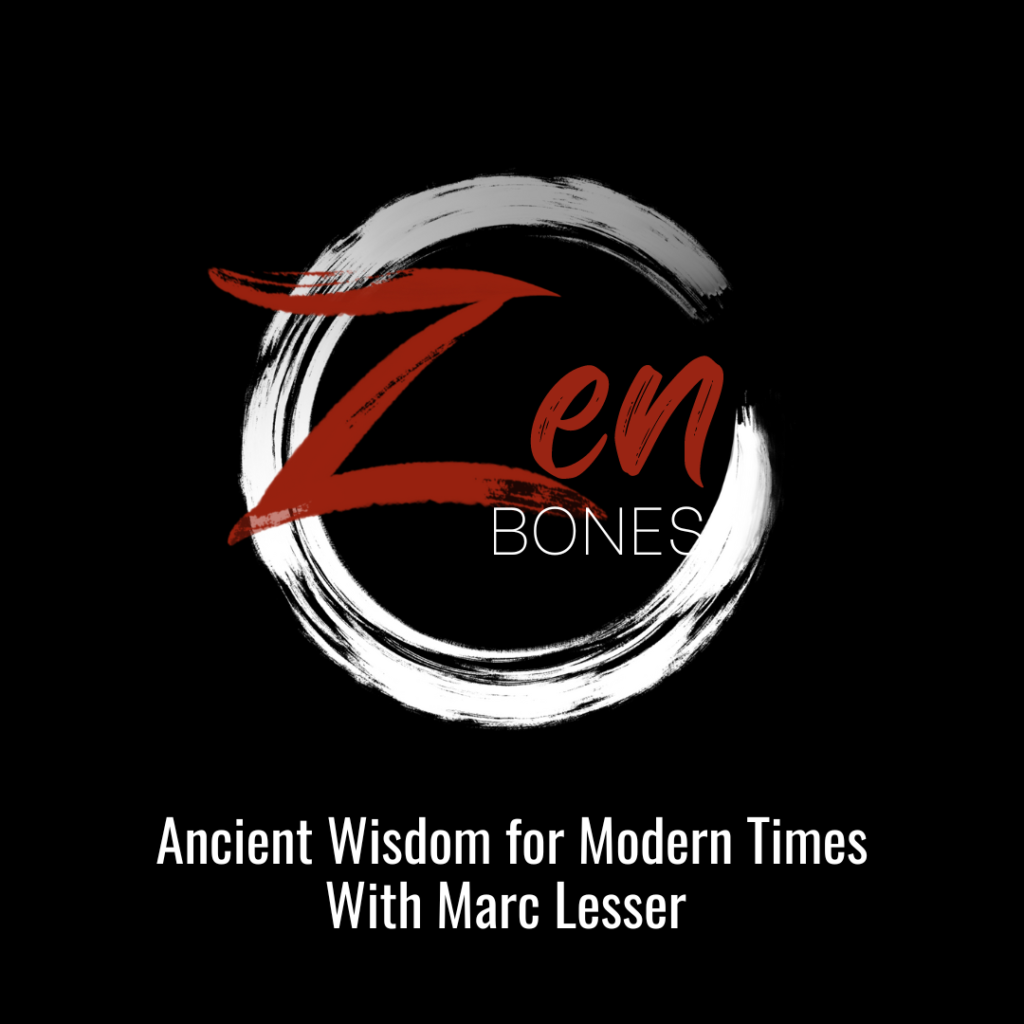Working skillfully and effectively with difficulties and challenges. Training ourselves to meet and transform difficulty. Marc begins with a short guided meditation followed by a talk on the topic of meeting challenge. This session’s Zen puzzler is “Can you step from the top of a one hundred foot pole?” – a traditional Zen teaching about doing what looks impossible.
EPISODE TRANSCRIPT
[music]
Marc: Welcome to Zen Bones: Ancient Wisdom For Modern Times. This is Marc Lesser. Why Zen Bones? Our world is in crisis and ever-shifting, and now more than ever, more wisdom, clarity, and courage are essential, especially in the world of work, business, and leadership.
In today’s practice episode, we begin with a short guided meditation with the theme of working with difficulties and challenges and working with the ordeals of our lives doing the impossible. A meditation practice itself, I think of as training to work skillfully effectively with difficulties and challenges.
I then do a short talk about this topic of seeing our lives, seeing meditation, seeing everything through this lens of challenges, and doing what is impossible. Training ourselves to do things that seem difficult. Building the courage to meet whatever comes our way, whether it’s parenting or relationships or work or politics. Integrating our genuine selves, our full selves into all parts of our lives. Impossible and yet.
Today’s Zen puzzler is also on this theme, and it’s stepping from the top of a hundred-foot pole. Practicing with what seems inconceivable. Training ourselves to cut through challenges and difficulties, and seeing how this is where the real beauty, the real sacredness, the real insights of being human are, by meeting what feels difficult or impossible. I hope you enjoy this practice episode. Thank you.
[music]
Let’s do some sitting practice together. I invite you to pause, to stop, and bring your attention to the body. Just noticing, finding a way to sit in a chair or a cushion or standing, maybe relaxing the muscles in the face, relaxing the jaw. Opening the chest and shoulders and arriving. This practice of arriving. Checking in with the body, noticing any places where you may be holding, restraining, and giving that place a bit of attention. Relaxing and noticing the breath, bringing attention to the breath. Breathing in, breathing out, and being aware of our thinking minds. Checking in.
Just being curious whether the mind is busy or calm, and gently bringing attention back to the body, to the breath. Just being here. In some way, I think of this practice as doing the impossible. Training ourselves to do what doesn’t seem possible. It doesn’t seem possible to be here. Our minds are usually very, very busy, very active, and it takes some effort to be here. Impossible. Can I be fully here? It’s the practice of accepting what is, and allowing our own insight, healing, learning through this practice of stopping, pausing. Allowing the great wisdom of our bodies and minds.
Impossible and yet just being here. How simple, just breathing and noticing anytime we are distracted, great to notice and coming back. Allowing breathing to be breathing. Allowing thinking to be thinking. Allowing our feelings and letting go. Letting go of our to-do lists. Letting go of expecting anything. Impossible to let go of expecting anything and yet this is our intention. This is our aspiration to be fully here. Curious, alert, relaxed, kind, kindhearted, warmhearted. Bringing a sense of warmth, bringing a sense of self-love and open openheartedness, open-mindedness, and keeping it simple.
Coming back, can always come back to the breath, can always come back to the body. Breathing in, breathing out. Simple. Impossible. Impossibly delicious to enjoy and appreciate our own breath. Please feel free to continue this practice, or you can join me for what’s next. Coming back.
[music]
I’m going to talk about this practice of doing the impossible. It was several years ago that I was designing a program aimed at training mindfulness teachers. I asked an old, old friend and mentor for some ideas on what elements he thought should be included in this endeavor. The aim was to train teachers to have the presence and confidence and competence to work with groups of business leaders and to teach meditation practice that included mindfulness and mindful leadership, as well as ways to develop emotional intelligence skills.
My friend’s advice was short and sweet and surprising. He said, “I suggest that you design an ordeal. Give them something that at first might seem impossible.” I was surprised and somewhat resistant hearing this advice. I wasn’t expecting to hear the word ordeal. However, the more I reflected on his advice, the more it fit. I realized that I had gone through somewhat of an ordeal in the process of developing my own confidence as a teacher, as a trainer, and as a leader as a CEO. I often felt like an imposter in the early days of standing on the stage of auditoriums at Google headquarters in Mountain View, leading meditations and mindfulness exercises for really bright and achievement-oriented engineers. I had a good deal of meditation experience, but I had very little experience in teaching meditation and very little track record of working in corporate settings.
It was intimidating, a lot walking through fire, but little by little through practice and a good deal of support, a good deal of learning and failing and growing I learned and I grew. In a way, this was my ordeal. It included my fears and mistakes and mustering the courage to keep going, even when I felt terrified.
I think we need these kinds of ordeals in our lives. I now begin my day with a comforting hot shower, but I’ve added the routine of turning on the cold water for several minutes, and each time it seems impossible and ridiculous as I watch my hand turn the shower knob from hot to cold. It’s shocking at first, and it wakes me up and it feels great. My whole body tingles with energy and a sense of accomplishment, like having gone through my fear, having gone through my resistance, even in this somewhat minor self-inflicted way, this ordeal.
I have a similar experience most mornings during my morning meditation practice. The idea of sitting still, aspiring to let go of my usual judgments and to focus on being curious and kind and loving. It feels impossible at times. My mind resists, my body resists, my mind continues to jump around and there’s voices of judgment.
Oh, what am I doing here? I have so many things I could be doing, and yet this is an important practice for me. Another one of my self-imposed, self-made ordeals. I’ve done many meditation retreats and there are a variety of motivations for engaging in these activities. One is this sense of doing what feels challenging, difficult, perhaps impossible. It’s a way of creating a fresh space, both ordinary and extraordinary, just sitting still and seeing what happens. In some way, these activities of cold showers or meditation retreats are warmups.
They’re relatively easy practices for dealing with the more impossible activities of our daily life and the ordeal of being human. How do we keep our hearts open in the time of war? Feels impossible. How do we take care of our aging parents or guide and protect our children? Again, feels impossible. How do we live our daily lives knowing that we will say goodbye to everyone and everything that we hold dear? Again, impossible.
We are impossible beings living during impossible times. I think it’s important to train ourselves to work through whatever challenges and ordeals help us to keep our hearts open, even and especially when it’s hard. This might include cold showers or meditation, or maybe for you, it’s sports or music or whatever activity is important. In our daily lives, raising children is an important impossible activity as is working and developing a career, making money, being in healthy intimate relationships, integrating our spiritual practice into our work, into our daily lives.
All extraordinary. And it’s all about I think the approach. How are we entering into all of these activities of our lives? It’s all impossible and it’s all easy and sacred and beautiful when we pay attention, when we bring our full selves, our full heart to our activities. Here’s a poem I want to share by Robert Bly about doing or thinking impossible things and this poem is called Things to Think. Think in ways you’ve never thought before. If the phone rings, think of it as carrying a message larger than anything you’ve ever heard.
Faster than a hundred lines of Yates. Think that someone may bring a bear to your door, may be wounded and deranged, or think that a moose has risen out of the lake and he’s carrying on his antlers. A child of your own whom you’ve never seen. When someone knocks on the door, think that he’s about to give you something large, tell you you’re forgiven, or that it’s not necessary to work all the time, or that it’s been decided that if you lie down, no one will die.
Please, let’s all practice with doing the impossible, thinking the impossible. I love this line to tell you that you are forgiven. Possible to be ourselves, to forgive ourselves, to give others, to find the courage, to be our full, genuine, authentic selves. Thank you.
[music]
Welcome to the Zen Bones puzzler, where I will regularly be presenting a story or a Zen koan or a poem. Something to contemplate, to think about a story that has purpose. It’s about developing greater insight and reflection. Not so much for a solution, but as a way to support your practice, a meditation in daily life
[music]
I’m very pleased to introduce today’s Zen Puzzler and this comes from a very traditional Zen koan. It is about stepping from the top of a hundred-foot pole. What happens? Can you step from the top of a hundred-foot pole? This is it. This is the puzzler. What is it like? What is it like to be perched on top of a pole? It looks dangerous. We can be completely filled with fear. Can we be relaxed? What to do? What do you do?
How do you respond? What is there to learn? What insight might you have from this Zen koan? This Zen Puzzler? You are perched at the top of a hundred-foot pole. This is a puzzle, a challenge that Shunryu Suzuki liked a lot and spoke about often during his talks.
There’s no real answer to this. In the zen tradition, these koans or these puzzles are meant to be considered, meant to be embodied. You might practice with what does it feel like. What is there to learn from being on top of a hundred-foot pole? This is a lot like the theme of this session about doing the impossible. This is an impossible situation. Again, I think much I was presenting earlier in meditation practice feels impossible. Taking a cold shower, raising our children, going to work, there’s so much that is seemingly incredibly challenging, incredibly impossible.
The question I think is, do we give into it or do we rise up? Do we use our hearts and our minds to look at things from a different perspective and even embody that we can do, we can go through, we can use these ordeals? This is a kind of ordeal being at the top of a hundred-foot pole. Yet, we can find our own sense of courage, our own sense of equanimity.
One of Shunryu Suzuki’s teachings about this particular puzzle is just say yes. The practice of just saying yes. Someone says, “Someone has made us breakfast,” and they say, “Breakfast is ready.” Instead of saying, “No, I’m reading the paper,” just let go of our own to-do lists. Let go of our own small minds. In a sense, this particular puzzle is an invitation to open to our bigger minds, to open our hearts, to just step in and say, yes to our own well-being. Yes to our meditation practice. Yes to integrating our genuineness, integrating our sense of wanting to make the world a better place, right in the midst of the divisiveness and impossibility of all of the challenges of this, the challenges of our inner worlds, the challenges of our outer worlds, the challenges of relationships impossible.
Being perched, stepping from the top of a hundred-foot pole is a reminder and encouragement to not be too caught by what looks impossible. We’re not on top of a hundred-foot pole. There is no pole. We’re right here on this earth, this ground being supported. Feeling and leaning in to the support, mustering our own confidence and humility. You might practice with this. See what is there for you to learn. What insights might you have from practicing with being perched stepping? Can you step from the top of a hundred-foot pole? Thank you very much.
[music]
Listen in each week for interviews, teachings, and guided meditations, you’ll receive supportive tools for creating more meaningful work and mindfulness practices to develop yourself, to influence your organization, and to help change the world. Thank you for listening.
[00:24:13] [END OF AUDIO]









